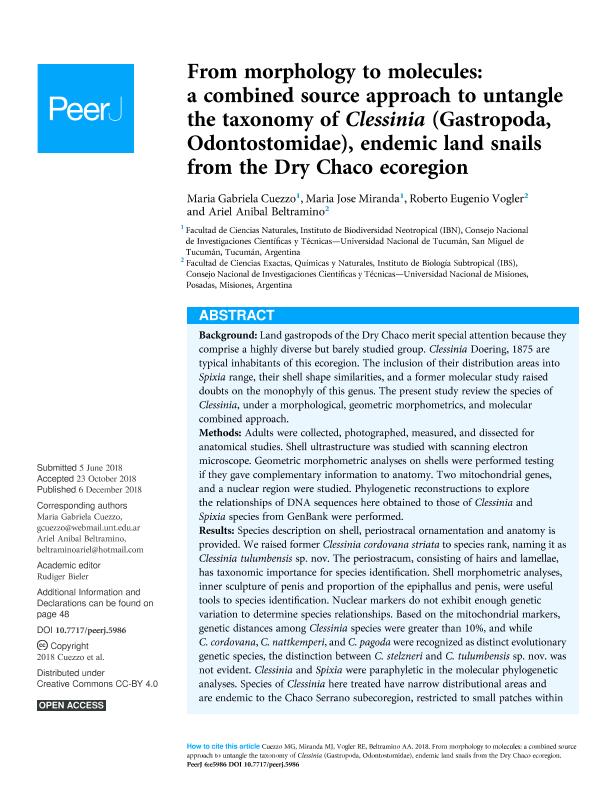Mostrar el registro sencillo del ítem
dc.contributor.author
Cuezzo, Maria Gabriela

dc.contributor.author
Miranda, Maria Jose

dc.contributor.author
Vogler, Roberto Eugenio

dc.contributor.author
Beltramino, Ariel Anibal

dc.date.available
2019-08-09T20:01:38Z
dc.date.issued
2018-12
dc.identifier.citation
Cuezzo, Maria Gabriela; Miranda, Maria Jose; Vogler, Roberto Eugenio; Beltramino, Ariel Anibal; From morphology to molecules: A combined source approach to untangle the taxonomy of Clessinia (Gastropoda, Odontostomidae), endemic land snails from the Dry Chaco ecoregion; PeerJ Inc; PeerJ; 2018; 12; 12-2018; 1-54
dc.identifier.issn
2167-8359
dc.identifier.uri
http://hdl.handle.net/11336/81357
dc.description.abstract
Background: Land gastropods of the Dry Chaco merit special attention because they comprise a highly diverse but barely studied group. Clessinia Doering, 1875 are typical inhabitants of this ecoregion. The inclusion of their distribution areas into Spixia range, their shell shape similarities, and a former molecular study raised doubts on the monophyly of this genus. The present study review the species of Clessinia, under a morphological, geometric morphometrics, and molecular combined approach. Methods: Adults were collected, photographed, measured, and dissected for anatomical studies. Shell ultrastructure was studied with scanning electron microscope. Geometric morphometric analyses on shells were performed testing if they gave complementary information to anatomy. Two mitochondrial genes, and a nuclear region were studied. Phylogenetic reconstructions to explore the relationships of DNA sequences here obtained to those of Clessinia and Spixia species from GenBank were performed. Results: Species description on shell, periostracal ornamentation and anatomy is provided. We raised former Clessinia cordovana striata to species rank, naming it as Clessinia tulumbensis sp. nov. The periostracum, consisting of hairs and lamellae, has taxonomic importance for species identification. Shell morphometric analyses, inner sculpture of penis and proportion of the epiphallus and penis, were useful tools to species identification. Nuclear markers do not exhibit enough genetic variation to determine species relationships. Based on the mitochondrial markers, genetic distances among Clessinia species were greater than 10%, and while C. cordovana, C. nattkemperi, and C. pagoda were recognized as distinct evolutionary genetic species, the distinction between C. stelzneri and C. tulumbensis sp. nov. was not evident. Clessinia and Spixia were paraphyletic in the molecular phylogenetic analyses. Species of Clessinia here treated have narrow distributional areas and are endemic to the Chaco Serrano subecoregion, restricted to small patches within the Dry Chaco. Clessinia and Spixia are synonymous, and the valid name of the taxon should be Clessinia Doering, 1875 which has priority over Spixia Pilsbry & Vanatta, 1894. Discussion: Our results support the composition of C. cordovana complex by three species, C. cordovana, C. stelzneri, and C. tulumbensis sp. nov. The low genetic divergence between C. stelzneri and C. tulumbensis sp. nov. suggests that they have evolved relatively recently. The former Spixia and Clessinia are externally distinguished because Clessinia has a detached aperture from the body whorl forming a cornet, periostracal microsculpture extended over dorsal portion of the peristome, five inner teeth on the shell aperture instead of three–four found in Spixia. Morphological similarities exists between both genera in shell shape, type of periostracum microsculpture, reproductive anatomy, besides the overlap in geographic ranges.
dc.format
application/pdf
dc.language.iso
eng
dc.publisher
PeerJ Inc
dc.rights
info:eu-repo/semantics/openAccess
dc.rights.uri
https://creativecommons.org/licenses/by/2.5/ar/
dc.subject
Argentina
dc.subject
Molecular Analyses
dc.subject
Periostracum
dc.subject
Spixia
dc.subject
Stylommatophora
dc.subject.classification
Ecología

dc.subject.classification
Ciencias Biológicas

dc.subject.classification
CIENCIAS NATURALES Y EXACTAS

dc.subject.classification
Genética y Herencia

dc.subject.classification
Ciencias Biológicas

dc.subject.classification
CIENCIAS NATURALES Y EXACTAS

dc.title
From morphology to molecules: A combined source approach to untangle the taxonomy of Clessinia (Gastropoda, Odontostomidae), endemic land snails from the Dry Chaco ecoregion
dc.type
info:eu-repo/semantics/article
dc.type
info:ar-repo/semantics/artículo
dc.type
info:eu-repo/semantics/publishedVersion
dc.date.updated
2019-08-01T21:51:14Z
dc.identifier.eissn
2167-8359
dc.journal.volume
2018
dc.journal.number
12
dc.journal.pagination
1-54
dc.journal.pais
Estados Unidos

dc.description.fil
Fil: Cuezzo, Maria Gabriela. Consejo Nacional de Investigaciones Científicas y Técnicas. Centro Científico Tecnológico Conicet - Tucumán. Instituto de Biodiversidad Neotropical. Universidad Nacional de Tucumán. Facultad de Ciencias Naturales e Instituto Miguel Lillo. Instituto de Biodiversidad Neotropical. Instituto de Biodiversidad Neotropical; Argentina
dc.description.fil
Fil: Miranda, Maria Jose. Consejo Nacional de Investigaciones Científicas y Técnicas. Centro Científico Tecnológico Conicet - Tucumán. Instituto de Biodiversidad Neotropical. Universidad Nacional de Tucumán. Facultad de Ciencias Naturales e Instituto Miguel Lillo. Instituto de Biodiversidad Neotropical. Instituto de Biodiversidad Neotropical; Argentina
dc.description.fil
Fil: Vogler, Roberto Eugenio. Consejo Nacional de Investigaciones Científicas y Técnicas. Centro Científico Tecnológico Conicet - Nordeste. Instituto de Biología Subtropical. Universidad Nacional de Misiones. Instituto de Biología Subtropical; Argentina
dc.description.fil
Fil: Beltramino, Ariel Anibal. Consejo Nacional de Investigaciones Científicas y Técnicas. Centro Científico Tecnológico Conicet - Nordeste. Instituto de Biología Subtropical. Universidad Nacional de Misiones. Instituto de Biología Subtropical; Argentina
dc.journal.title
PeerJ
dc.relation.alternativeid
info:eu-repo/semantics/altIdentifier/doi/http://dx.doi.org/10.7717/peerj.5986
dc.relation.alternativeid
info:eu-repo/semantics/altIdentifier/url/https://peerj.com/articles/5986/
Archivos asociados
